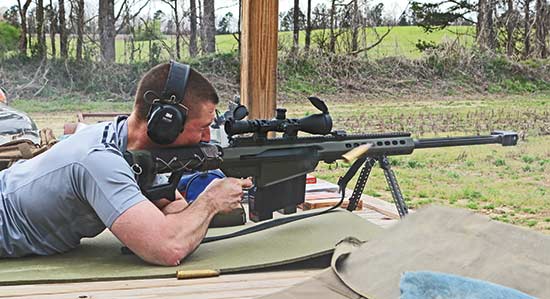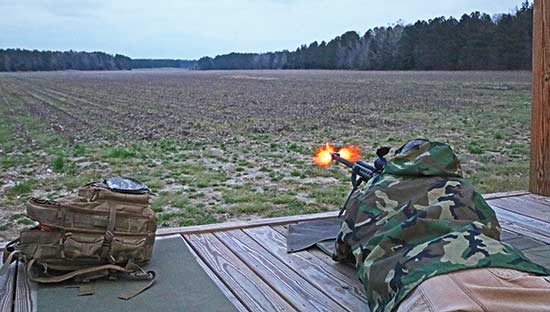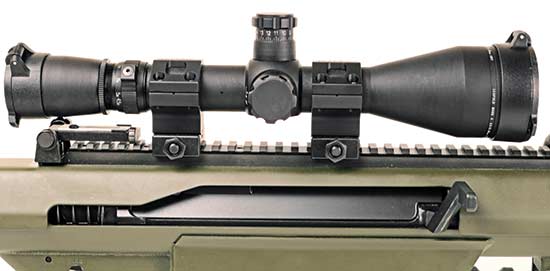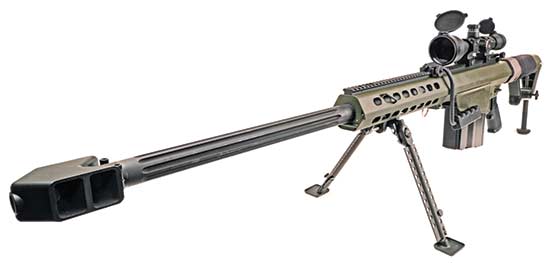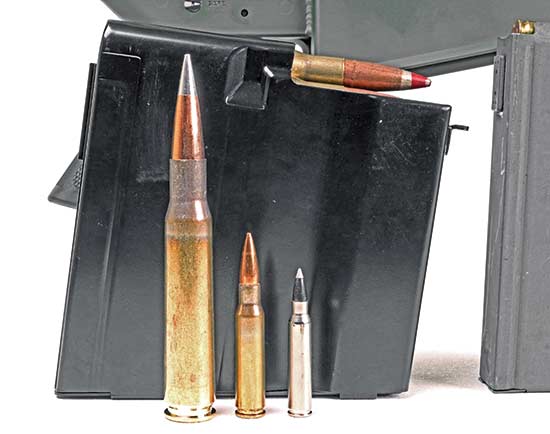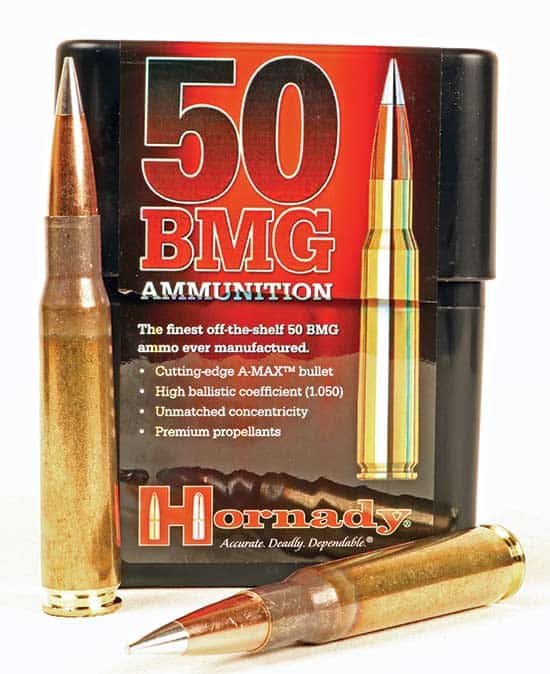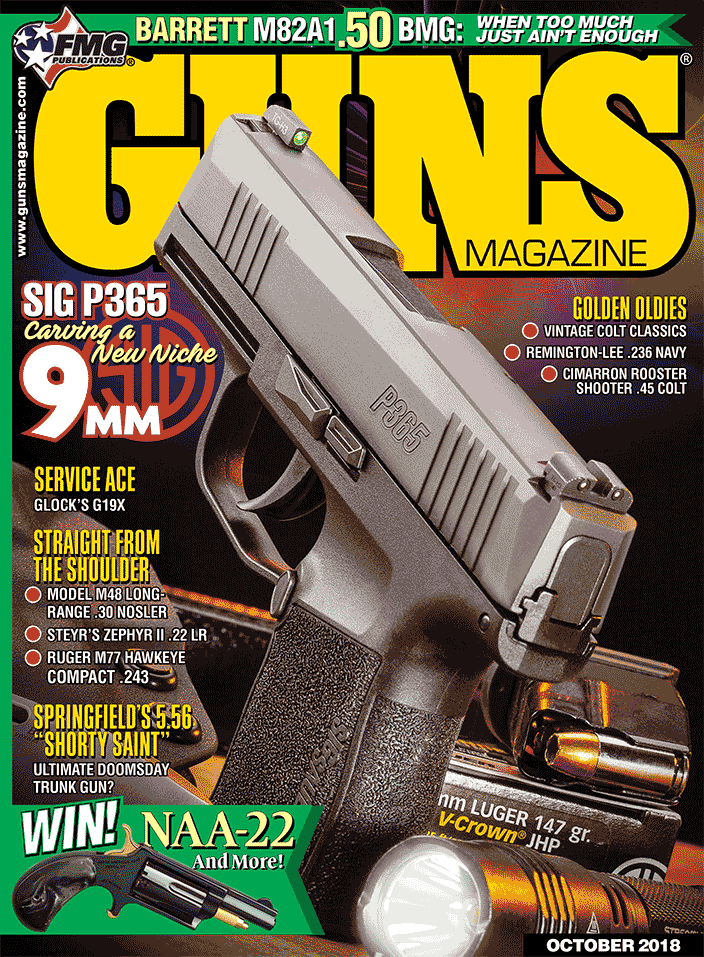Barrett's Mighty M82A1
Why? Because Anything Worth Doing Is Worth Doing To Excess
In 1982, Commodore International released its Commodore 64 8-bit home computer. My doorbell has more computing power today, but the 64 became the bestselling personal computer of all time.
In the same year Ronnie Barrett started Barrett Firearms Manufacturing with the purpose of producing a viable shoulder-fired semi-auto .50 BMG rifle.
John Browning thought up this behemoth cartridge — and the machinegun built around it — to bring down balloons in the First World War. General John “Blackjack” Pershing, the commander of the American Expeditionary Forces, initially requested the weapon. Browning’s .50 went on to arm tanks, trucks, naval vessels and combat aircraft throughout the global cataclysm of the Second World War.
The .50 BMG round was simply a scaled-up version of the .30-06 service cartridge. This beast was nearly 5.5″ long and fired a 750-gr. bullet at around 2,800 fps. The M2 HB (Heavy Barrel) gun that launched it weighed 84 lbs. On the surface it might seem physically impossible to produce a handheld firearm capable of managing such formidable chaos. Ronnie Barrett felt otherwise.
Engineered Awesomeness
Everything in the gun world seems to somehow trace back to John Moses Browning. He designed the Auto-5 shotgun. Orbiting around a radical long-recoil action wherein the barrel and bolt recoil briefly as a unit before separating to perform their ejection and reloading chores, Browning always claimed the Auto-5 was his best achievement. Ronnie Barrett adapted the concept to the .50 BMG cartridge. The end result is breathtakingly effective.
The M82 first sold to Sweden but has since seen service in 51 different countries. There are lighter versions today, but the standard M82A1 rifle feeds from a 10-round magazine, weighs about 30 lbs. and is 48″ long (as in four feet). Upon firing the bolt and barrel recoil together through about an inch before they part ways. Separate springs drive both the barrel and bolt home. This makes for a lot of mechanical clutter in the action. However, the various parts do not start to move until after the bullet leaves the barrel, so it remains a remarkably accurate platform.
The receiver of the M82A1 is formed from pressed steel, and there is a long Picatinny rail up top for optics. The gun comes with a folding ladder rear sight, but the scope must be physically removed to access it. The forward backup iron sight folds into the rail when not in use. The gun’s built-in folding bipod does not pivot but is readily adjustable for command height. The folding carrying handle and bipod are both removable. There is an adjustable monopod on the buttplate allowing for fine adjustments without tools.
The massive barrel is fluted to improve rigidity and conserve weight. The muzzlebrake on my gun is an enormous harmonica-type. The gun disassembles via pull pins without tools, and there are two rigid sling mounts on opposite sides of the receiver.
The Leupold Mk 4 is the optic most commonly associated with the rifle. This rugged scope is built around a 30mm tube and offers a side-mounted focus knob. Finger-adjustable quarter-MOA windage and elevation adjustments operate with both audible and tactile clicks. Once sighted properly, the adjustment knobs can be zeroed for easy reference.
The pistol grip is the same sort found on an M4 and the left-sided safety lever is similarly configured. The massive 10-round box magazine is easy to load, and the magazine release is a rear-mounted lever akin to a Kalashnikov. The charging handle is rigidly affixed to the bolt carrier and reciprocates with it.
The .50 BMG Experience
Humping this thing is a gut check. Everything about the gun is awkward. It’s too long to sling comfortably and too heavy to toss across your back. While just getting it out of the gunroom I bump into stuff relentlessly. A friend who served as a sniper in a Ranger battalion in Afghanistan told me they could indeed connect out to 1,600 meters. However, they most typically carried their Barretts disassembled between two Rangers.
But once you get to the range the thing is actually fun. No kidding. Recoil is breezy. I’d put it in the same league as a 20-gauge shotgun. I could shoot it all day without leaving a shoulder bruise. Muzzleblast, however, is another thing entirely.
I stood off to the side to take some pictures. Holy snot! It was like shoving lit firecrackers up my nose. The concussion simultaneously cleared my sinuses and loosened my fillings. Lash down nearby gear lest it be launched downrange or torn asunder.
The gun runs just like an enormous AK47. Magazines have to be rocked in place, and the gun charges from the right. The monopod lets you really dial in your shots, and the recoil impulse is more shove than thump.
The trigger is intentionally long and heavy. A single .50 BMG round is the Newtonian equivalent of firing 13 5.56 rounds at one time. You do not want this thing going off unexpectedly. As a result, the trigger has a long take-up but a predictable break.
Reach Out And Touch Someone
Everything about owning and shooting an M82A1 is expensive. I got mine on sale, but a Rolls Royce bought on sale still costs a holy fortune. The Barrett is a similar extravagance.
I opted for the cheapest ammo I could find and landed 200 rounds at about $3 a pop. Half was ball and the other half APIT (Armor Piercing Incendiary Tracer). These rounds were loaded using salvaged components from demilled military surplus rounds, and you get what you pay for. At 100 meters they group around 3″. Garbage in, garbage out. However, switching to some Hornady Match ammo tightened my groups to a legitimate half-inch or so.
We spent an afternoon with the gun on a 1,500-yard range. After obtaining a 100-yard zero we used a Kestrel 5700 Elite Weather Meter to calculate our ballistic solutions. This got us close, even at 1,000 yards. With an experienced trigger finger, a good spotter, and the Hornady ammo, the gun will indeed connect with a 12″ square steel plate a grid square away. The APIT also made a nice flash on impact.
The Barrett M82A1 is an amazing piece of engineering. EOD guys with whom I served used theirs to detonate unexploded ordnance at safe distances. Military snipers use them to bring the pain on lightly armored targets like aircraft and radar systems at comfortable standoff ranges. Guys like me just look at ours lovingly and then use them to blow the living crap out of the occasional derelict lawnmower. It’s an expensive way to dispose of unwanted yard maintenance equipment, but nothing does it better.
Barrett
https://gunsmagazine.com/company/barrett-firearms-mfg-inc/
Ph: (615) 896-2938
